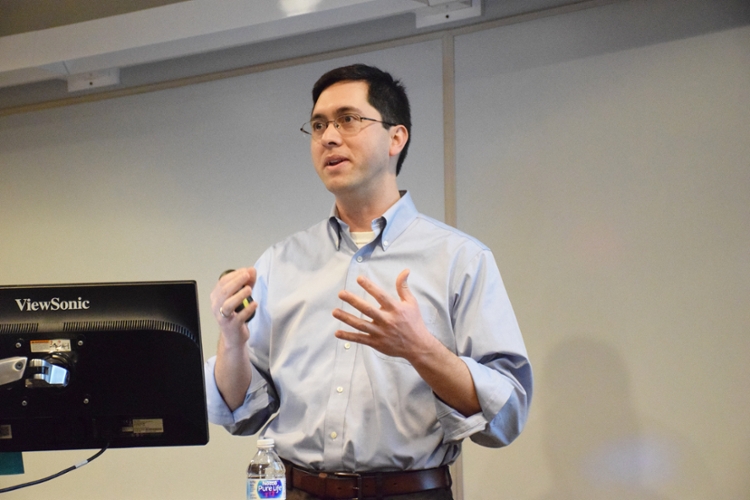Overcoming Barriers to Safety Net Sign-Ups
Pennsylvania experiment tests outreach to those unenrolled
Get all our news

IPR economist Matthew Notowidigdo presents his research at a Fay Lomax Cook Monday Colloquium.
Millions of Americans rely on social safety net programs like unemployment insurance, housing assistance, Medicaid, and the Supplemental Nutrition Assistance Program (SNAP)—formerly known as food stamps. But enrollment in these programs is not automatic and requires people to apply and demonstrate their eligibility. As a result, many of the programs, which could potentially benefit low-income or disabled Americans, are below their enrollment capacity. So, why do people fail to sign up for social safety net programs like SNAP, despite being eligible?
IPR economist Matthew Notowidigdo and his MIT colleague Amy Finkelstein are seeking to understand this issue by examining how to improve outreach methods to low-income households not participating in social safety net programs.
A number of barriers prevent eligible people from signing up for SNAP, Notowidigdo said during a February IPR colloquium covering the research. Given that people must apply for enrollment, they might not know about the program, or they might not know that they are eligible. Additionally, the stigma surrounding food assistance or receiving other government aid could prevent eligible low-income people from applying.
“[Applying] is an ordeal that requires effort and people might not think that it’s worth doing that in order to get benefits from the program,” Notowidigdo said.
Notowidigdo and Finkelstein wanted to see if having additional information would increase SNAP enrollment. They decided to focus on the elderly, since they have the lowest enrollments in SNAP.
The researchers conducted a randomized experiment in 2016, contacting 30,000 elderly Pennsylvanians who were likely eligible for SNAP but were not enrolled. They partnered with the Benefits Data Trust, a nonprofit that helps people access public benefits like healthcare and food, to provide information and assistance.
They divided this population of potential SNAP enrollees into three groups, mailing two of them information about the program. One of these groups also received additional assistance—a toll-free number run by the nonprofit—with their application process. A third group, the control group, received neither the information nor assistance.
Over the next nine months, only 6 percent of the control group enrolled in SNAP. However, 11 percent of the information-only group and 18 percent of the information-plus-assistance group enrolled. Those who called in and talked to someone at the Benefits Data Trust were more likely to sign up for SNAP, too.
Of the options examined, the information-only method might be the more cost-effective one, Notowidigdo said. The cost per enrollee was $20, compared with $65 for those who received information plus assistance. The researchers interpreted their findings using an economic model and concluded that both interventions are a cost-effective way to redistribute income to low-income households, relative to other tax and transfer policies.
“Our work is part of an active and growing area of economics trying to learn more about people ‘leaving benefits on the table,’” Notowidigdo said. “Economists—ever the dismal scientists—sometimes argue that this phenomenon might be a feature, not a bug. Maybe there is a logic to these ordeals that deter people from signing up. At least that’s the theory. But I think our research adds a lot more nuance to this discussion, and hopefully will help guide future researchers who are considering similar outreach efforts either for SNAP, or for other social programs.”
Find the paper here. Notowidigdo presented the research on July 24, 2018 at the National Bureau of Economic Research summer institute in Cambridge, Massachusetts.
Matthew Notowidigdo is associate professor of economics and IPR fellow.
Published: September 17, 2018.